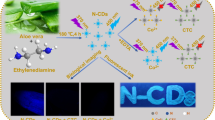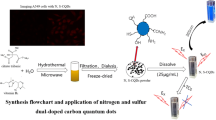Abstract
This article reports on the synthesis of water dispersible carbon quantum dots (CDs) by a one-step hydrothermal method using polyamidoamine (PAMAM) and (3-aminopropyl)triethoxysilane (APTES) as a platform and passivant. The resulting CDs are highly uniform and finely dispersed. The synergistic effect between PAMAM and APTES on the surface of the CDs results in a fluorescence that is much brighter than that of CDs modified with either APTES or PAMAM only. The fluorescence of the co-modified CDs is quenched by Hg(II) ions at fairly low concentrations. Under the optimum conditions, the intensity of quenched fluorescence drops with Hg(II) concentration in the range from 0.2 nM to 10 μM, and the detection limit is 87 fM. The effect of potentially interfering cations on the fluorescence revealed a high selectivity for Hg2+. The fluorescent probe was applied to the determination of Hg(II) in (spiked) waters and milk and gave recoveries between 95.6 and 107 %, with relative standard deviation between 4.4 and 6.0 %.

Strongly fluorescent carbon quantum dots (CDs) modified with polyamidoamine (PAMAM) and 3-aminopropyltriethoxysilane (APTES) were synthesized by one-step hydrothermal strategy. The resulting co-modified CD s were used as fluorescent probe for sensitive and selective detection of Hg2+.






Similar content being viewed by others
References
Orihel DM, Paterson MJ, Blanchfield PJ, Bodaly RA(DREW), Hintelmann H (2007) Experimental evidence of a linear relationship between inorganic mercury loading and methylmercury accumulation by aquatic biota. Environ Sci Technol 41:4952–4958
Lin YH, Tseng WL (2010) Ultrasensitive sensing of Hg2+ and CH3Hg+ based on the fluorescence quenching of lysozyme type VI-stabilized gold nanoclusters. Anal Chem 82:9194–9200
Gil S, Lavilla I, Bendicho C (2006) Ultrasound-promoted cold vapor generation in the presence of formic acid for determination of mercury by atomic absorption spectrometry. Anal Chem 78:6260–6264
Zhu ZL, Chan GC-Y, Ray SJ, Zhang XR, Hieftje GM (2008) Use of a solution glow discharge for cold vapor generation of mercury with determination by ICP-atomic emission spectrometry. Anal Chem 80:7043–7050
Khvostikov VA, Telegin GF, Grazhulene SS (2003) Determination of mercury by nondispersive atomic fluorescence spectrometry. J Anal Chem 58:519–523
Ugo P, Moretto LM, Bertoncello P, Wang J (1998) Determination of trace mercury in Saltwaters at screen-printed electrodes modified with Sumichelate Q10R. Electroanal 10:1017–1021
Chai F, Wang TT, Li L, Liu HY, Zhang LY, Su ZM, Wang CG (2010) Fluorescent gold nanoprobes for the sensitive and selective detection for Hg2+. Nanoscale Res Lett 5:1856–1860
Xia YS, Cao C, Zhu CQ (2007) Selective detection of mercury(II) and copper(II) based on the opposite size-dependent fluorescence quenching of CdTe quantum dots. Chinese J Chem 25:1836–1841
Chang MMF, Ginjom IR, Ngu-Schwemlein M, Ng SM (2016) Synthesis of yellow fluorescent carbon dots and their application to the determination of chromium(III) with selectivity improved by pH tuning. Microchim Acta 183:1–9
Yan FY, Kong DP, Luo YM, Ye QH, He JJ, Guo XF, Chen L (2016) Carbon dots serve as an effective probe for the quantitative determination and for intracellular imaging of mercury(II). Microchim Acta 183:1611–1618
Guo Y, Yang LL, Li WW, Wang XF, Shang YH, Li BX (2016) Carbon dots doped with nitrogen and sulfur and loaded with copper(II) as a “turn-on” fluorescent probe for cystein, glutathione and homocysteine. Microchim Acta 183:1409–1416
Zuo PL, Lu XH, Sun ZG, Guo YH, He H (2015) A review on syntheses, properties, characterization and bioanalytical applications of fluorescent carbon dots. Microchim Acta 183:519–542
Bourlinos AB, Stassinopoulos A, Anglos D, Zboril R, Karakassides M, Giannelis EP (2008) Surface functionalized Carbogenic quantum dots. Small 4:455–458
Dong W, Dong Y, Wang Y, Zhou SQ, Ge X, Sui LL, Wang JW (2013) Labeling of human hepatocellular carcinoma cells by hexamethylene diamine modified fluorescent carbon dots. Spectrochim Acta A 116:209–213
Wang YF, Dong LH, Xiong RL, Hu AG (2013) Practical access to bandgap-like N-doped carbon dots with dual emission unzipped from PAN@PMMA core-shell nanoparticles. J Mater Chem C 1:7731–7735
Han BF, Wang WX, Wu HY, Fang F, Wang NZ, Zhang XJ, Xu SK (2012) Polyethyleneimine modified fluorescent carbon dots and their application in cell labeling. Colloid Surface B 100:209–214
Hui P, Jadranka TS (2009) Simple aqueous solution route to luminescent Carbogenic dots from carbohydrates. Chem Mater 21:5563–5565
Li QH, Tang WJ, Wang Y, Di JW, Yang JP, Wu Y (2015) Electrochemiluminescence immunosensor for ketamine detection based on polyamidoamine-coated carbon dot film. J Solid State Electrochem 19:2973–2980
Sun FR, Chen FF, Fei WJ, Sun L, Wu Y (2012) A novel strategy for constructing electrochemiluminescence sensor based on CdS-polyamidoamine incorporating electrodeposited gold nanoparticle film and its application. Sensors Actuators B Chem 166-167:702–707
Yan FY, Zou Y, Wang M, Mu XL, Yang N, Chen L (2014) Highly photoluminescent carbon dots-based fluorescent chemosensors for sensitive and selective detection of mercury ions and application of imaging in living cells. Sensors Actuators B Chem 192:488–495
Tao H, Hu TT, Yan JL, Di JW (2015) A comparative study of different reagentless plasmon sensors based on Ag-Au alloy nanoparticles for detection of Hg. Sensors Actuators B Chem 208:43–49
Li HB, Li YL, Cheng J (2010) Molecularly imprinted silica nanospheres embedded CdSe quantum dots for highly selective and sensitive optosensing of Pyrethroids. Chem Mater 22:2451–2457
Mao Y, Bao Y, Han DX, Li FH, Niu L (2012) Efficient one-pot synthesis of molecularly imprinted silica nanospheres embedded carbon dots for fluorescent dopamine optosensing. Biosens Bioelectron 38:55–60
Lu WB, Qin XY, Liu S, Chang GH, Zhang YW, Luo YL, Asiri AM, Al-Youbi AO, Sun XP (2012) Economical, green synthesis of fluorescent carbon nanoparticles and their use as probes for sensitive and selective detection of mercury (II) ions. Anal Chem 84:5351–5357
Gao ZH, Lin ZZ, Chen XM, Lai ZZ, Huang ZY (2016) Carbon dots-based fluorescent probe for trace Hg2+ detection in water sample. Sensors Actuators B Chem 222:965–971
Yan FY, Shi DC, Zheng TC, Yun KY, Zhou XG, Chen L (2016) Carbon dots as nanosensor for sensitive and selective detection of Hg2+ and L-cysteine by means of fluorescence “off–on” switching. Sensors Actuators B Chem 224:926–935
Zhang RZ, Chen W (2014) Nitrogen-doped carbon quantum dots: facile synthesis and application as a “turn-off” fluorescent probe for detection of Hg2+ ions. Biosens Bioelectron 55:83–90
Liu Y, Liu CY, Zhang ZY (2012) Synthesis of highly luminescent graphitized carbon dots and the application in the Hg2+ detection. Appl Surf Sci 263:481–485
Lin Z, Dou XN, Li HF, Chen QS, Lin JM (2014) Silicon-hybrid carbon dots strongly enhance the chemiluminescence of luminol. Microchim Acta 181:805–811
Liu RL, Wu DQ, Liu SH, Koynov K, Knoll W, Li Q (2009) An aqueous route to multicolor photoluminescent carbon dots using silica spheres as carriers. Angew Chem 121:4668–4671
Lu X, Imae T (2007) Dendrimer-mediated synthesis of water-dispersible carbon-nanotube-supported oxide nanoparticles. J Phys Chem C 111:8459–8462
Wang F, Xie Z, Zhang H, Liu CY, Zhang YG (2011) Highly luminescent Organosilane-functionalized carbon dots. Adv Funct Mater 21:1027–1031
Hou YX, Lu QJ, Deng JH, Li HT, Zhang YY (2015) One-pot electrochemical synthesis of functionalized fluorescent carbon dots and their selective sensing for mercury ion. Anal Chim Acta 866:69–74
Li Z, Wang Y, Ni Y, Kokot S (2015) A rapid and label-free dual detection of Hg (II) and cysteine with the use of fluorescence switching of graphene quantum dots. Sensors Actuators B Chem 207:490–497
Acknowledgments
We gratefully acknowledge the financial support extended by the National Natural Science Foundation of China (No. 21475092), the Project Funded by the Priority Academic Program Development of Jiangsu Higher Education Institutions (PAPD), the Project of Scientific and Technologic Infrastructure of Suzhou (SZS201207), and the Open Research Project of the Battery Technology Innovation Center for Public Services of Jiangsu Province (HDP201206).
Author information
Authors and Affiliations
Corresponding author
Ethics declarations
The author(s) declare that they have no competing interests.
Electronic Supplementary Material
ESM 1
(DOC 182 kb)
Rights and permissions
About this article
Cite this article
Tang, W., Wang, Y., Wang, P. et al. Synthesis of strongly fluorescent carbon quantum dots modified with polyamidoamine and a triethoxysilane as quenchable fluorescent probes for mercury(II). Microchim Acta 183, 2571–2578 (2016). https://doi.org/10.1007/s00604-016-1898-0
Received:
Accepted:
Published:
Issue Date:
DOI: https://doi.org/10.1007/s00604-016-1898-0




